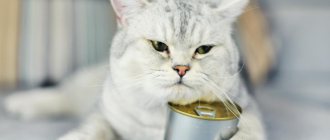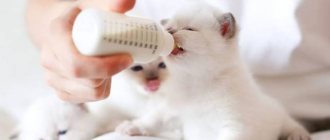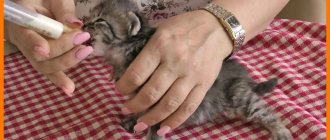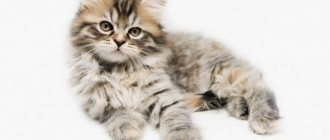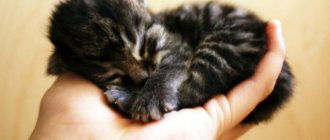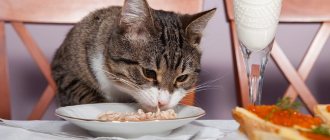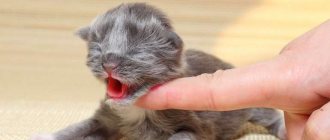As a rule, kittens are separated from their mother at the age of 2-3 months. During this time, the cat learns all the skills necessary in adult life: eating solid food, using a tray and scratching post, communicating with relatives and people. A kitten up to 3 months old, feeding on mother's milk, receives primary immunity with it, which helps the pet stay healthy.
However, sometimes it happens that the mother cat is not around and she cannot feed the kittens. In such cases, feeding fragile babies falls on the shoulders of the owner. In such cases, you will have to carefully study the rules of how and what to feed a one-month-old kitten without a cat.
Basics of proper nutrition
When deciding how to feed a one-month-old kitten, you need to decide whether in the future it will eat ready-made factory feed or natural food. The pros and cons of both feeding options have been controversial for a long time. Mixing both types of feeding is not recommended. And there are objective reasons for this: different types of food are digested in different ways and for different amounts of time. An animal eating dry food needs more water.
It may not be easy to immediately choose the right nutrition among commercial feeds: ready-made feeds can differ greatly in composition. It is not recommended to mix food of different brands, as this can cause an oversaturation of the body with microelements and vitamins. The consequences of poor nutrition can be serious problems with digestion and gastrointestinal tract.
Even having decided on the option of feeding the baby, there are a number of rules that are important to follow:
- Feeding a one-month-old kitten should be divided into 6-8 servings. At the same time, you need to make sure that your pet does not overeat. The serving size should take into account the food option (natural or dry), as well as the breed and future size of the adult.
- New foods are introduced into the diet separately and gradually. Monitor your cat's reaction to each new product introduced. If problems with digestion or stool occur, the introduction of this product should be postponed.
- If you are feeding natural foods, you may need to add vitamins to your diet. But it is still recommended to consult a veterinarian first.
- And the most important rule is that the chosen feeding option must be of high quality.
Dry food – helper or enemy?
There is still fierce debate about whether feeding kittens dry food is beneficial. On the one hand, such food really exists and can provide the kitten with the necessary nutrients. At the same time, a kitten accustomed to Hills or Whiskas will subsequently be very difficult to switch to regular food.
There is also a more compelling reason to temporarily abandon dry food in the diet of a four-legged baby in the first month of his life. Generally safe for an adult animal, they can “give” a kitten indigestion, constipation, and serve as the onset of urolithiasis. And, ultimately, significantly shorten the animal’s lifespan.
Whatever you choose to feed a grown cat, it is better to feed the cub with healthy, balanced food, with plenty of milk and meat porridge. Take care of the health of your four-legged happiness so that he will delight you with his purring for as long as possible!
What else to see:
How to train a kitten to eat on its own
Teaching your baby to eat on his own does not take much time and effort. Already from the 3rd week of life, kittens are actively interested in how their adult relatives eat. At the same time, kittens are of little interest in the contents of the bowl.
First, placing a saucer in front of your pet, you should invite him to “take a sample” of the new food from his finger. He will quickly realize that it is very tasty and will then try to eat the prepositional delicacy from the bowl. Instincts will already tell you how to eat the offered treat.
At first, it’s best to keep an eye on your kitten’s meals. A baby, captivated by a delicious dinner, can get its paws into the bowl, then it is necessary to explain that this cannot be done. In time he will learn manners.
It is better to start the first complementary food for one-month-old kittens with easy-to-digest and liquid foods. If it was decided to feed the kitten natural food, it could be chopped chicken or beef fillet in broth, or liquid porridge. Gradually, the amount of liquid in a serving decreases, teaching you to eat solid food.
If the pet only drinks from the entire portion, but does not eat its portion, the meat can be ground in a blender to a porridge state. Next time he himself will look for pieces of meat in his portion.
Rules for introducing complementary foods
The little pet begins to be fed from 4-8 weeks, gradually diluting the milk menu with more solid products. When introducing complementary foods, follow these rules:
- Puree your meals and focus on carbohydrates and calcium. Cook milk porridges and use a limited amount of meat until baby teeth erupt.
- Add new dishes at intervals of 2-3 days to track the body's reaction. This will help identify allergies and food intolerances.
- Offer to try unfamiliar food straight from your finger. After approval, it can be poured or transferred to a bowl.
- Consider your pet's tastes. If the cat refuses the food offered, you should not force feed it. Thanks to the variety of possible options, the diet can be chosen to suit every taste.
- Avoid food that is too hot or cold. Temperatures above and below room temperature can injure mucous membranes.
- Don't leave uneaten food for later. To avoid indigestion and poisoning, serve only fresh food.
- Try to eliminate sources of noise while eating. Without being distracted by irritants, the baby will focus more on food and quickly learn to eat on his own.
- Avoid overfeeding. Not all babies feel full. It is safer to feed them often, but in small portions.
You can determine the time of introducing complementary foods in the presence of a mother cat by changing her behavior. By 4-6 weeks after birth, her milk supply decreases, so she increasingly leaves the “nest”. With the developed maternal instinct, the pet begins to take the cubs to the kitchen, showing them bowls of food. By repeating after their mother, babies quickly learn to eat on their own.
Feeding diet for one-month-old kittens
The most suitable option for feeding a kitten, especially one left without a cat, is a special milk formula. Cat milk replacers are sold in pet stores and veterinary pharmacies in powder form. Some of the most famous and widespread are: Beaphar Kitty Milk, Babycat Milk Royal Canin, Gimpet Cat-Milk.
Such mixtures are convenient and easy to use. The powder just needs to be diluted in warm water, stirring thoroughly so that there are no lumps. The manufacturer always describes in detail the process of preparing the mixture, the required proportions and amount of powder for the serving size for the specific weight and age of the baby. As a rule, the finished mixture is stored in the refrigerator for no more than a day.
Feeding a kitten with milk alone at 1 month is no longer enough. It is from this moment that you can begin to introduce additional complementary foods, and milk or its substitute is given only 2 times a day.
Natural nutrition for a one-month-old kitten
Let's figure out what to feed a kitten for 1 month, which in the future will eat natural food? You can start introducing the following products:
- Meat products. It should be lean meat; chicken and beef work well. If the baby refuses to eat pieces of prepositional meat, you should make meat puree for the first feeding, gradually increasing the number of pieces of meat in the portion. It will be healthier and tastier for a small growing organism if the meat offered is raw. And to avoid the risk of infecting with dangerous parasites, the product should first be frozen for a couple of days in the freezer. If you are still worried about this processing method, you can check the product used.
- Low-fat fermented milk products. Kefir, yogurt, fermented baked milk, sour cream, and yogurt are suitable. It is important that all products offered are without flavoring additives. You can also offer soaked cottage cheese. But it is recommended to give all these products no more than once a week.
- Whole milk. When choosing a diet, remember that babies cannot digest any type of milk (except cat milk) in its pure form. And with age, the body’s ability to absorb lactose is completely lost.
- Vegetables. Carrots, broccoli, zucchini, asparagus, green beans, and celery are given as additives to the meat diet. Vegetables are a good source of vitamins and fiber. No more than 10% of vegetables from the total diet are needed per day. It is important that vegetables are convenient to eat.
- Eggs. The yolk is preferable. Like meat, it is recommended to serve it raw. According to veterinarians, cats cannot digest boiled eggs.
- Low-fat sea fish. Low-fat, protein-rich, and low-bone marine and oceanic fish species are good for feeding a kitten. Like all other products, it is healthier to serve fish raw, after freezing it in the freezer for a couple of days. The opinion that cats should be fed only one fish is far from the truth. With such a diet, vitamin B1 deficiency may occur.
Ready-made food for kittens at 1 month
What to feed one-month-old kittens when feeding factory-made food? When choosing a brand and manufacturer, check whether the selected food is suitable for a one-month-old kitten. The main thing here is not to cheapen, do not fall for advertising and carefully study the composition on the packaging. When considering this type of feeding, it is important to assume that a cat is a carnivore, and a carnivore needs to eat meat to remain healthy and active.
Recommended food for one-month-old kittens who are just starting to get acquainted with adult food:
- The Royal Canine brand of food has a line of food for pregnant cats and kittens from 1 to 4 months - Royal Canine Mother and Babycat. The manufacturer advises, during the process of accustoming to adult food, to offer this food along with canned food for kittens from 1 to 4 months.
- Brit brand food is offered for kittens Brit Care Cat Crazy I'm Kitten. The basis of the food is chicken and rice. Chicken meat is easily digestible by small kittens and is rich in amino acids, and rice does not cause allergies and is also well digested. The remaining components of the food help the pet grow healthy.
- Acana Cat & Kitten food is suitable for all ages, including those starting complementary feeding and transitioning to dry food. These foods are available in several flavors, but all meet the requirements of the cat’s body, including a kitten from 1 month old.
- Grandorf Lamb & Rice Kitten is a low-grain food for nursing and pregnant cats and kittens. According to the manufacturer's description, this food is suitable for kittens from 3 weeks of age. The composition of the feed promotes good digestion, healthy growth and development. Does not contain ingredients harmful to domestic predators.
It is important to understand that when choosing factory feed and making your life easier, you need to carefully study the composition and its components.
The same principle works when choosing canned food, chosen as the first complementary food or as a treat for your beloved pet. The composition should be as accurate and transparent as possible; there should be no questions about the quantity and origin of meat ingredients.
With any feeding option chosen, it is important that the baby has constant access to fresh water.
What not to feed a kitten
It is very important to feed your kitten correctly. Proper feeding of the baby from childhood is the key to health in adulthood.
Contrary to popular belief, kittens should not be fed whole milk, neither cow's nor goat's. Most kittens do not digest the lactose contained in milk, and adult cats develop natural lactose intolerance as they age. The mysterious substance lactose is a type of sugar. Whole milk in the diet can lead to serious gastrointestinal problems such as stomach cramps and diarrhea. In addition, pets do not receive any beneficial substances from milk. Alternatives are ready-made formulas for small kittens or homemade milk formulas.
In no case should you neglect the rule: do not feed the kitten from the table. Human food contains excess fats, seasonings and spices that are not suitable for a cat's body.
Fatty meat and fatty trimmings in the diet lead to the development of pancreatitis and liver problems.
Bones can seriously injure the esophagus and gastrointestinal tract.
Sweets provoke the development of liver failure and diabetes.
Pork and sausage can cause pancreatitis, liver cirrhosis and acute kidney failure.
Raisins and grapes cause poisoning.
conclusions
Kittens are very fragile creatures. Their diet should consist of proven products and feed. Water should also be used that is specially purified to prevent your pet from developing an intestinal infection. For proper development, you need to take the kitten outside more often. Sunlight and fresh air promote the formation of endogenous vitamin D, necessary for bone growth and healthy claws and fur.
It is important that the animals are mobile. To do this, you should play with the kitten more often. Only then will its development be harmonious. Any changes in the behavior and condition of the pet should not go unnoticed. In accordance with age, it is recommended to carry out all necessary preventive vaccinations. This will protect not only the cat, but also its owners from diseases. If possible, you should choose the best vitamins for kittens. Then the pet will not have health problems in the future. You should undergo a medical examination by a veterinarian several times a year in order to identify signs of disease in advance and prevent them.
Feeding regimen and norm
The feeding regimen for kittens is determined according to age. Here you need to follow the rule: the younger the kitten, the more often it needs to be fed. A one-month-old kitten needs to be fed every 4 hours, including at night. At 5-6 weeks, the number of feedings is reduced to 4 times a day. Foods are introduced into the menu of a stronger baby and the number of milk feedings is reduced.
For kittens up to 1 month old, the best nutrition is mother's milk; she will determine how much her cubs need. If a kitten is being fed by a person, then on special milk formulas the manufacturer gives detailed instructions on the daily amount per 100 grams of the baby’s weight. At the age of 2-3 weeks, the feeding rate per day is about 38-48 ml. For a kitten from 1 month of age, the feeding rate increases to 53 ml per day.
In the future, when transferring the baby to adult food, you should know the norm of how much food to give per day, so as not to encounter health problems for your pet.
If the choice was made in favor of dry food, the number of grams per day is usually written on the packaging depending on the weight and age of the pet. But it is also worth considering the fact that the numbers on the packaging are averaged and it is better to monitor your pet’s weight for some time in order to notice changes in time and adjust the daily norm in one direction or another.
In the case of natural feeding, the norm is calculated using a formula based on the fact that a growing cat’s body should eat food weighing about 10% of its own weight. Using this formula, you can safely feed a kitten until it reaches 9 months, after which the daily norm is reduced to 5% per day.
What is needed to feed a kitten
To successfully feed a kitten without a cat, the following fundamental elements are necessary:
- nutrition - its composition and feeding regimen, as well as compliance with certain rules when feeding;
- temperature regime - kittens do not have the ability to effectively thermoregulate, and therefore they are susceptible to hypothermia;
- hygiene - kittens need assistance with urination and defecation; it is necessary to monitor the cleanliness of their fur and den.
Setting up a nest for a kitten left without a mother
The kitten needs a constant temperature regime, and external stimuli are also undesirable for it, so you should arrange a den for the baby:
- You can use a thick cardboard box or something else as a basis.
- Cover the bottom with dense thermal insulation material, for example, a blanket, and put a disposable diaper on top.
- Cover the top of the box with a warm woolen cloth.
A den for kittens should be warm and safe.
You can place a soft fluffy toy in the kitten's box.
Temperature
Maintaining the desired temperature in the den is possible using:
- incandescent lamps placed above the den;
- bottles of hot water, tightly closed and wrapped in a towel so as not to burn the kitten;
- regular heating pads, also covered with a towel.
When installing heating, it is important to leave one corner of the den free from it. The kitten will hide in this place if it gets hot.
Temperature:
- for the first week of a kitten’s life, the temperature of the den is maintained at 27–32 °C;
- second week - 27–29 °C;
- During the third and fourth weeks, the temperature is successively lowered so that by the end of the 4th week it reaches 24 °C.
Necessary items for feeding
To feed a kitten you will need:
- bottles for formula milk;
- nipples;
A bottle for kittens with nipples is sold in a veterinary pharmacy
- an alternative to a bottle with a nipple: a syringe without a needle - it is convenient to dose the mixture, which can be fed directly from the syringe;
- soft catheters with side holes, they are put on a syringe and used for feeding kittens;
- plastic bottles with medicine pipettes, very thoroughly washed;
Feeding rules
When feeding, keep in mind that:
- the mixture should be warm, you can check this by dropping a drop on the bend of your elbow or wrist, the optimal temperature of the mixture is 38 ° C;
- the remaining mixture can be stored in the refrigerator, but no more than a day;
- to prevent aspiration (fluid entering the kitten’s respiratory tract): avoid the use of kitten feeding devices with wide openings;
- the formula for feeding a kitten is not fed under pressure, the kitten sucks it itself, and the person only helps;
- when feeding, the kitten is positioned belly down;
Kittens are fed in a belly down position
Video: how to bottle feed a kitten
Kitten hygiene
The immunity of a kitten left without a cat is very weak. Therefore, the person who has taken responsibility for the baby must strictly adhere to the rules of care:
- For the first three weeks of a kitten's life, he needs to massage the abdomen and perianal area in order to induce urination and defecation. This is done using a damp linen napkin. Massage should be done after each feeding.
- The diaper the kitten is wearing must be dry and clean, and it must be changed more often (daily or when soiled).
- The skin of the kitten's abdomen is susceptible to irritation. To prevent it, wipe it with baby oil; if irritation occurs, use baby powder.
- They always prepare food for the kitten, and also feed and care for it only with clean hands and in clean clothes, in which there has been no contact with other cats, since a baby growing without a mother does not have colostral immunity, and it is not yet capable of producing its own antibodies.

